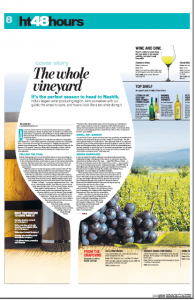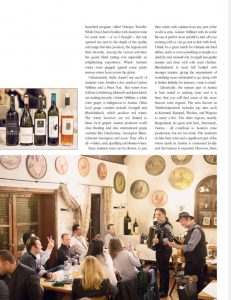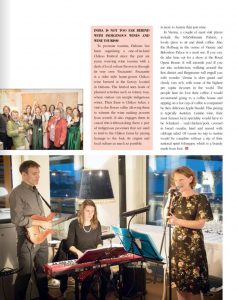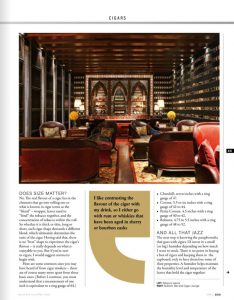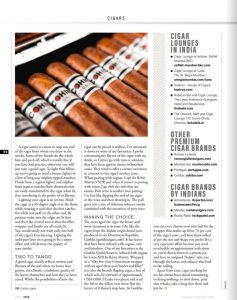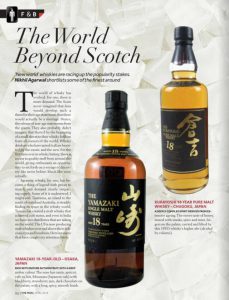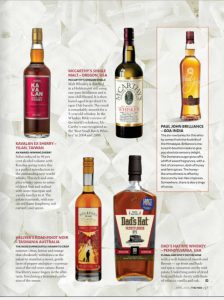Category Archives: Media Articles
Blackbook – SUBMIT- An evening of Art, food and single malts at the Masque
Single malt and food are art forms and with SUBMIT guests are asked to submit their senses to the evening as premium single malts and an elaborate menu are paired with a collection of art, music and poetry. The malts on the menu include Talisker 10 YO, Glenkinchie 12 YO, Dalwhinnie 15 YO, Cragganmore 12 YO, Caol Ila 12 YO and Lagavulin 16 YO. The evening promises to be a completely unique sensory experience and comes with a surprise element with every course.
Hospitality Biz – All Things Nice acknowledges India’s best wines at IWCCA 2018
The best wines in categories of Gold, Silver and Bronze were selected through a process of blind tasting of over 120 different varieties by 105 selected wine consumers from India, Chile, Argentina, Japan, Australia, UK, France, Italy, etc. through a four-hour process held earlier this year in Mumbai.
The gold winners at IWCCA 2018 were Big Banyan Bellisima NV, Big Banyan Cabernet Sauvignon 2016, Casablanca Vino Spumante NV, Charosa Reserve Tempranillo 2015, Four Seasons Classic Chenin Blanc 2017, Good Earth Antaraa NV, Grovers Art Collection Cabernet Shiraz 2017, Grovers Chêne 2015, KRSMA Cabernet Sauvignon 2015, Oakwood Reisha Shiraz 2015, SDU Reserva Syrah 2013, SDU Deva Chardonnay NV, Sula Riesling 2017, Sula Sauvignon Blanc 2017, Sula Zinfandel Rosé 2017, Syonaa Shiraz NV, Vallonné Merlot Reserve 2014 and Vallonné Viognier Reserve 2017
FnBnews.com – Celebrating India’s Finest
HT Cafe – Tales from the oak barrel
Society Magazine – That’s the Spirit, Austria – By Nikhil Agarwal
Society Magazine – That’s the Spirit, Austria – By Nikhil Agarwal
Vienna is the only capital city in Europe to have vineyards. This means it is incredibly easy to get a serious dose of Austrian wine culture and not have to travel far to get it. I’ve been to Austria specifically twice and driven through it to go from Germany to Italy and back a number of times making brief stops in Innsbruck and the Alps. The first time I went as a back packer, I ate chips for breakfast lunch and dinner and drank copius amounts of Guinness in the evenings. I stayed in a hostel, walked around the capital city and even managed to get the cheapest ticket to a show at the stunning Vienna Opera House where Shri Pandit Ravi Shankar played with his daughter Anushka.
Almost 18 years later I was invited by the good people at Vinexpo and the Austrian Wine Marketing Board for a quick 3 day introduction to 90 wine producers and their wines for a newly program launched program called Vinexpo Traveler. While i have been familiar with Austrian wine for sometime, well atleast I thought, this trip opened my eyes to the depth of the quality and range that they produce, the regions and their diversity. As part of the activities, a grand blind tasting pegging Austrian wines against some pretty serious wines from across the globe was an enlightening experience and enough to convince you that Austrian wine is truly world class.
Unfortunately India doesn’t see too much Austrian wine besides a few random Gruner Veltliners and a Pinot Noir or two but I’m confident that as we go along more Indian consumer’s will develop a thirst for them. In India, wines from Schloss Gobelsburg, Heinrich and Jurtschitsch are making in roads. It is a pleasure to see people like Michael Moorsbrugger of Schloss Gobelsburg investing time and energy on creating demand for Austrian wine in India where the quanitities being imported cannot be exciting. Also Willi Klinger, CEO of the Austrian Wine Marketing Board and his fantastic team for bringing the world to experience Austrian wine.
Griuner Veltliner is indigineuos to Austria and is responsible for putting them on the global wine map. Other local grape varieites include Zwiegelt and Braufrankisch which produce red wines. The wines however are not limited to these local grapes. Austria produces world class Riesling and also international grape varieties like Chardonnay, Sauvignon Blanc, Cabernet Sauvignon and more. They offer it all – whites, reds, sparkling and dessert wines. If you have not tried Austrian wine till now, it would be wise to give it a shot. This is by no means a new phenomenon, they have been producing quality wines for a long time, it’s just that we haven’t noticed.
Since Austrian wine can be diverse, to pair their wines from cuisines from any part of the world is easy. Gruner Veltliner with its acidity is perfect to start off your evening with as an aperitif or can go just as fine with food. I thinks it’s a great match for Chinese stir fried dishes, sushi, or even something as simple as a daal fry and roomali roti. Zwiegelt has gentle tannins and does well with roast chicken for example. Blaufrankisch is more full bodied with stronger tannins giving the requirement of something more substantial to go along with it, Indian kebabs come to mind.
Climatically the eastern part of Austria is best suited to making wine and it is here that you will find some of the more famous wine regions. The area known as Niederrosterreich includes top sites such as Kremstal, Kamptal, Wachau, and Wagram to name a few. The other regions namely Burgenland, they do great reds here, Steiermark, Vienna all cntribute to Austria’s wine production but are not alone, wine is produced in other parts of Austria too. The Austrians do like their wine and a signfificant part of the wines made in Austria is consumed locally and the balance exported to all corners of the world in increasing numbers.
My first impression of Vienna when I got there years ago the first time still stands today. Vienna is uber grand and clearly very rich with per capita incomes being some of the highest in the world. They do love their coffee, I would recommend going to a coffee house and sipping on a hot cup of coffee and eating their delicous Apple Strudel. This pairing is typically Austrian and is fantastic. I also think that Austria does otstanding desserts and if you have a sweet tooth, you cannot go wrong here.
Cullinary wise the most famous local speciality would have to be Schnitzel, veal/chicken/pork covered in bread crukbs and fried served with cabbage salad. Meat that’s fried, how perfect. I was surpirsed to see how much I liked cabbage salad. Of course no trip to Austria would be complete without a sip of schnapps, their national spirit which is brandy made from fruit.
In Vienna a couple of must visit places include the Schonbrunn Palace, a lovely place to sit and drink coffee and watch the grandness of this palace. Also the Hofburg in the centre of Vienna & Belvedere Palace is a must see. If you can, do take in a show at the Royal Opera House, it will astonish you. If you’re into architecture, walking around the first dristrict and ringstrasse will keep you in wonder.
Wine tourism in Austria is picking up and the vineyards in the city make it super easy. Or you could rent a car and drive around to visit some of the winerie. From my last visit a few wineries really got my interest and if you get a chance it be good to give them a visit. Domane Wachau, Topf Johann, Sepp Moser, Nigl, Lenz Moser, are some of the producers that come to my mind in terms of quality but there are many more including the wines I mentioned earlier.
To finish, there is enough beauty, wine and food to keep you well engaged if you decide to go there purely for a wine and food experience. If Austria isnt on your list of must go places then like their wines I urge you to give it a try.
Celebrating India’s Finest 2018




Business Traveller – Plush Puffs
Business Traveller – Plush Puffs
Cigar smoking is still a new concept to most Indians. Here is a breakdown of how to enjoy a good quality roll by Nikhil Agarwal.
- Cigar Lounge at Artisan, Sofitel Mumbai BKC; sofitel-mumbai-bkc.com
- Cigar Lounge at Luna, The St. Regis Mumbai; stregismumbai.com/luna
- Kastros – House of Cigars; kastros.com
- Rubicon Bar and Cigar Lounge, The Leela Ambience Gurugram Hotel and Residences; theleela.com
- The Cheroot, Malt and Cigar Lounge, ITC Grand Chola, Chennai; itchotels.in
- Churchill: seven inches with a ring gauge of 47.
- Corona: 5.5- to six inches with a ring gauge of 42 to 44.
- Petite Corona: 4.5 inches with a ring gauge of 40 to 42.
- Robusta: 4.75 to 5.5 inches with a ring gauge of 48 to 52.
- Romeo y julieta; romeoyjulietacigars.
com - Montecristo; montecristo.com
- Partagas; partagas.com
- Cohiba; cohiba.com
- Armenteros; itcportal.com/
businesses/fmcg - Meluha; meluhacigars.com
- Rocky Patel; rockypatel.com
The Man – The World Beyond Scotch
Japanese whisky for one has become a thing of legends with prices to match, demand clearly out pacing supply. Some of it is undeserved though I might add. Tasmania in Australia is steadily finding its space in the whisky world, Taiwan has created a malt whisky that achieved cult status and even in India we have two distilleries that are taking on the world. The USA is now producing malt whiskies over above their delicious ryes and bourbons. Here are a couple that have caught my attention lately –
DALWHINNIE 15 YO – HIGHLAND, SCOTLAND
Gold with a crisp, dry and very aromatic with hints of heather and peat on the nose. Light to medium bodied with a smooth and lasting flavours of honey sweetness & vanilla followed by deeper citrus flavours
BUNNAHABHAIN 18YO – ISLAY SCOTLAND
A rich mahogany Single Malt Scotch Whisky, this is one of the Bunnahabhain family favourites. It is intensely warming; with dried fruit, sherry, toffee and spices leading to a delicious honeyed nuttiness and the slightest hint of sea salt.
PAUL JOHN BRILLIANCE – GOA INDIA
The six-row barley for this whisky comes from the foothills of the Himalayas. Brilliance is matured in bourbon casks, to give you absolute sensory delight. The demerara sugars give off a whiff of sweet fragrances, with a hint of cinnamon, dash of honey and faint spices. The honey-like smoothness is offset by the crunchy-bar-like crispness. Somewhere, there is also a tinge of cocoa.
YAMAZAKI 18 YEARS OLD – OSAKA JAPAN
Rich with mature autumn fruit, with a deep amber colour. The nose has raisin, apricot, cafe au lait, Mizunara (Japanese oak) with blackberry, strawberry jam, dark chocolate on the palate with a long, spicy, smooth finish.
KURAYOSHI 18 YEAR PURE MALT WHISKY – CHUGOKU JAPAN
A deeply complex spirit derived from extensive aging. The sweet taste of honey, mixed with smoke, spice and mint, lingers on the palate, carried and lifted by this 18yr whisky’s higher abv.
KAVALAN EX SHERRY – YILAN, TAIWAN
An award winning Sherry Solist reduced to 46% alcohol volume with Kavalan spring water, this is a perfect introduction to the outstanding new world whisky. This rich and complex whisky opens onto notes of dried fruit and walnut with some marzipan and vanilla touches to it. The palate is smooth, with rancio red fruits (raspberry, red currant) and spices.
HELLYER’S ROAD PINOT NOIR – TASMANIA AUSTRALIA
The nose is immediately drawn to crisp summer citrus, lemon and orange that obediently withdraws on the palate to manifest a sweet, gentle layer of pepper and spice – a persuasion of the red wine cameo. Burnt blackberry sauce lingers in the aftertaste foreclosing a treasured confusion of the senses.
COMPASS BOX HEDONISM – SCOTLAND
A celebration of that ideal marriage between distilled spirit and high quality oak maturation. The aromas and flavours hint of vanilla, caramel, a delicate fruitiness, accented by flashes of coconut in the finish. This is a whisky that will appeal to both the ardent whisky enthusiast and newcomers to whisky alike.
MCCARTHY’S SINGLE MALT – OREGON, USA
McCarthy’s Oregon Single Malt Whiskey is distilled in a Holstein pot still using one pass distillation and is non-chill filtered. It is then barrel-aged in air-dried Oregon Oak barrels. The result is remarkably smooth for a 3-year-old whiskey. In the Whiskey Bible’s review of the world’s whiskeys, McCarthy’s was recognized as the “Best Small Batch Whiskey” in 2004 and 2006.
DAD’S HAT RYE WHISKEY – PENNSYLVANIA, USA
Floral and spicy on the nose with a well-balanced mouth feel and flavor — up-front and back-end spice, cinnamon on the mid-palate. Underlying notes of dried fruit and black cherry with hints of tobacco, vanilla and oak.
Business Traveller – The Mexican Spirit
There is another side to tequila that most people are unaware of. Rather than being gulped, it is meant to be sipped on and savoured, where its complexity, incredible flavour and aroma take centre stage. Don’t get me wrong. I have enjoyed the good old “lick salt, shoot tequila, squeeze lime” protocol many a time (the Mexicans too drink it neat, but without the fanfare). And I’ve enjoyed it as part of margaritas and other classic tequila-based cocktails too that drown out the pungency of its cheaper version. Just like vodka or other spirits, tequila too caters to every level of the alcohol spectrum, from the foul and potent to the sublime and complex. Top-end tequila can be just as pleasurable as top-end whisky, cognac,
cognac, armagnac or in some cases, even great wine. armagnac or in some cases, even great wine. Artisanal tequila is the fruition of craftsmanship and tradition rather than industrial production. The knowledge has been passed down generations, right from how to cultivate it, to tend to it and finally yield the returns.
The blue agave plant from which tequila is made thrives in specific Mexican regions, where millions of them are harvested each year. Depending on the region in which it is produced, the blue agave offers different aromas and flavours. It takes about eight to 12 years to reach maturity. After this, the juice is sucked out from its leaves, and fermented before being distilled twice. It is then immediately bottled as tequila or aged further in wooden barrels for a stronger flavour. I love how people way back in the Aztec ages came up with the recipe for this from a plant that looks and feels incredibly hostile.
Tequila is a region specific name for the distilled spirit that, according to Mexican laws, must be produced in Jalisco, and in certain areas of Guanajuato, Michoacan, Nayarit, and Tamaulipas. It is in Jalisco, where the on the bottle better. Blanco or white tequila has either not been aged at all or has been aged for less than two
months in wooden barrels. It is definitely not a tequila that can be sipped and savoured by any standards. The texture is more harsh.
The joven or oro variety of tequila is not aged. They are coloured and flavoured with caramel. Reposado or rested tequila is aged from two to 12 months in oak barrels. Here, the barrel infuses the spirit with additional flavours and complexity. Anejo tequila is obtained when it spends a minimum of one to three years in an oak barrel. Extra anejo is aged for a minimum of three years. Personally, I prefer tequila that has spent a good amount of time in an oak barrel, such as extra anejo. It is simply because it takes on a smoother, creamier texture, and the aromas are more alluring. In India, we have a plethora of tequila brands mixed into cocktails, and gulped down without really having to taste their flavours. In some cases, this is probably a good thing because they’re more likely to be joven or oro. We also have a few fine tequila brands such as Don Julio Anejo (donjulio.com/our-tequilas), Patron Silver patrontequila.com) and Corralejo Anejo (tequilacorralejo.com.au). It would be absolutely sacrilegious to have them in any way that doesn’t involve being sipped and savoured. For such brands, I would do away with the shot glass completely and pour it cold, or put one cube of ice into a brandy balloon and enjoy it slowly. If you’re ordering shots of any of these three brands, and plan to drink them without actually tasting their flavours, let me remind you, it would be a waste of good tequila.
Cocktail culture is beginning to take off in India. We have already started to understand that the quality of any cocktail depends on the quality of its ingredients. As we become more aware as consumers, we want the taste of the spirit to be highlighted rather than muted in our cocktails. This is why drinking quality tequila will become more important to people in the know, and the notion that tequila too can be a fine spirit will finally catch on.


